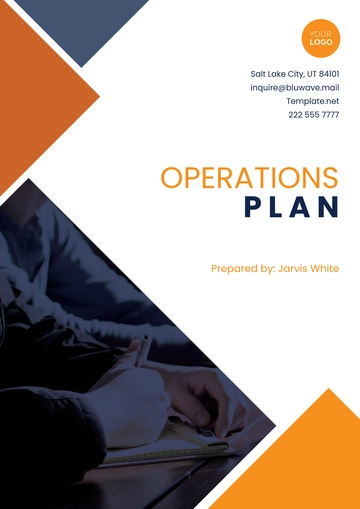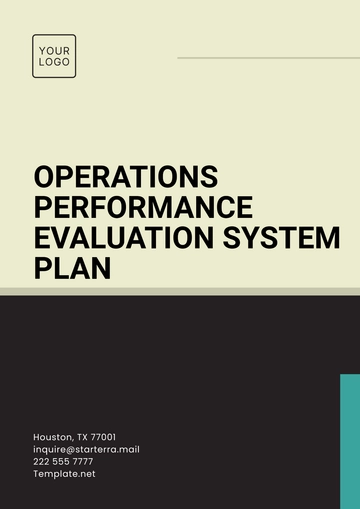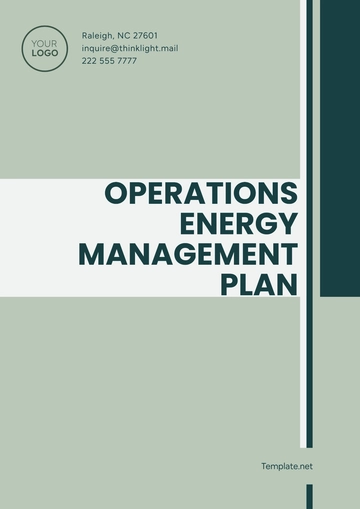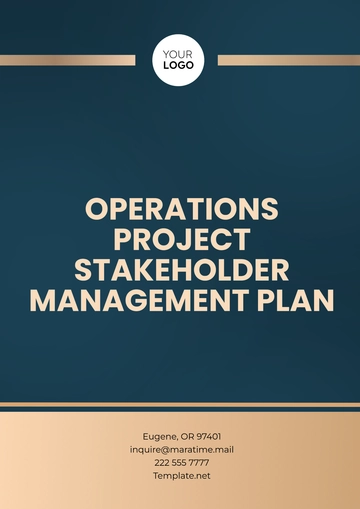Free Logistics Company Transport Plan

1. Executive Summary
The logistics industry is poised for a transformative shift driven by advancements in technology, evolving customer demands, and a heightened focus on sustainability. [Your Company Name] recognizes the importance of adapting to these changes to maintain a competitive edge and ensure long-term success. This Transport Plan outlines our strategic vision for 2050 and beyond, focusing on enhancing operational efficiency, implementing sustainable practices, and leveraging technology to meet the evolving needs of our customers. Our commitment to innovation and sustainability will be key pillars in shaping our future operations and service offerings.
2. Company Overview
Founded in [Year], [Your Company Name] has established itself as a leader in the logistics sector, specializing in transportation and distribution services across various industries. Our commitment to excellence and customer satisfaction has fueled our growth and positioned us as a trusted partner for businesses seeking reliable logistics solutions. As we look toward 2050, our vision is to become the most customer-centric logistics company, leveraging innovation and sustainability to redefine industry standards.
We aim to continuously enhance service delivery by investing in state-of-the-art technology, training our workforce, and fostering a culture of adaptability. Our strategy will prioritize customer feedback and market trends, ensuring we remain responsive to the ever-changing logistics landscape.
3. Market Analysis
3.1 Industry Trends
The logistics industry is projected to experience significant growth in the coming decades, driven by the following trends:
E-commerce Expansion: The rise of online shopping is resulting in increased demand for rapid and reliable delivery services. By 2050, e-commerce is projected to account for over [30%] of total retail sales, necessitating efficient logistics solutions. As a response, we will enhance our last-mile delivery capabilities to ensure quick and accurate fulfillment.
Sustainability Initiatives: Growing consumer awareness of environmental issues is prompting companies to adopt sustainable practices. By 2055, [Your Company Name] aims to reduce its carbon footprint by [20%] through eco-friendly transportation methods. This commitment will not only help protect the planet but also align our brand with the values of environmentally conscious consumers.
Technological Advancements: The integration of technology, such as artificial intelligence (AI) and automation, is revolutionizing logistics operations. Companies that embrace these innovations will gain a competitive advantage and improve service efficiency. We plan to implement AI-driven analytics to optimize our supply chain management and enhance decision-making processes.
3.2 Competitive Landscape
The logistics market is characterized by intense competition, with numerous players offering similar services. Key competitors include [Competitor A], [Competitor B], and [Competitor C]. To differentiate ourselves, [Your Company Name] will focus on:
Superior Customer Service: We aim to enhance the customer experience through personalized service and real-time tracking capabilities. Our customer service team will be available 24/7 to address inquiries and resolve issues promptly.
Sustainable Practices: Our commitment to sustainability will resonate with environmentally conscious consumers and businesses. By promoting our green initiatives in marketing campaigns, we will attract customers who prioritize sustainability in their supply chain choices.
Technological Innovation: By investing in the latest logistics technologies, we will streamline our operations and improve delivery accuracy. We will also explore partnerships with tech companies to stay ahead of emerging trends and tools.
4. Objectives
To successfully implement our transport plan, [Your Company Name] has established the following objectives:
Enhance Operational Efficiency: Achieve a [15%] reduction in operational costs through improved route optimization and fleet management by 2055. Regular audits and performance metrics will be used to track progress toward this goal.
Expand Service Offerings: Introduce same-day and next-day delivery options, capturing an additional [20%] market share by 2057. This will involve investing in additional warehousing and last-mile delivery infrastructure to meet increasing consumer expectations.
Achieve Carbon Neutrality: Implement sustainable practices to become carbon neutral by 2050, contributing positively to global climate initiatives. We will actively engage in carbon offset programs to balance our emissions during the transition period.
Improve Customer Satisfaction: Achieve a customer satisfaction rating of [90%] or higher by 2055, driven by superior service and technology integration. Regular surveys and feedback loops will help us assess customer sentiment and make necessary adjustments to our services.
5. Transport Network Design
5.1 Distribution Centers
[Your Company Name] will strategically establish distribution centers to optimize our transport network. These facilities will be located in key regions to facilitate efficient distribution, reduce transit times, and lower transportation costs. Our distribution centers will be equipped with advanced technology to enhance inventory management and order processing.
These centers will also incorporate environmentally friendly designs, including solar panels and rainwater harvesting systems, to reduce operational costs and minimize our ecological impact.
Distribution Center Location | Primary Functions | Expected Capacity (units) |
|---|---|---|
City A | E-commerce fulfillment | [500,000] |
City B | Bulk storage and regional distribution | [750,000] |
City C | Cross-docking and sorting | [300,000] |
5.2 Route Optimization
To maximize efficiency, [Your Company Name] will implement advanced route optimization software. This technology will analyze real-time traffic data, delivery schedules, and customer locations to determine the most efficient delivery routes. By 2050, we aim to reduce average delivery times by [25%], enhancing customer satisfaction while minimizing fuel consumption.
Additionally, we will conduct regular training sessions for our drivers on eco-friendly driving practices, further contributing to fuel savings and reduced emissions.
5.3 Fleet Management
Our fleet will consist of a mix of vehicles, including electric trucks and autonomous delivery vehicles, to reduce environmental impact. By 2050, [Your Company Name] plans to have [50%] of its fleet converted to electric vehicles, which will help us significantly cut down on greenhouse gas emissions. Furthermore, regular maintenance schedules and telematics systems will be implemented to monitor vehicle performance and optimize fuel efficiency.
Investments in fleet tracking technology will allow us to provide real-time updates to customers regarding their shipments, enhancing transparency and trust.
Vehicle Type | Total Fleet Size | Electric Vehicles | Autonomous Vehicles |
|---|---|---|---|
Light-duty Trucks | [1,000] | [500] | [100] |
Heavy-duty Trucks | [500] | [250] | [50] |
Delivery Vans | [700] | [350] | [0] |
6. Operational Strategy
6.1 Transportation Modes
[Your Company Name] will utilize a multi-modal transportation strategy that incorporates road, rail, air, and sea transport to optimize delivery times and costs. By 2055, we aim to enhance our intermodal capabilities to provide customers with flexible shipping options. Each mode of transport will be selected based on factors such as distance, urgency, and cost-effectiveness.
This approach will not only allow for more efficient use of resources but also provide clients with customizable solutions that fit their specific logistics needs.
6.2 Technology Integration
To streamline operations and improve service delivery, we will invest in advanced technologies, including:
Transportation Management Systems (TMS): Implementing a TMS will enable us to plan, execute, and optimize the movement of goods, providing greater visibility and control over our logistics operations. This system will also facilitate seamless communication between departments, ensuring everyone is aligned.
Warehouse Management Systems (WMS): A WMS will enhance inventory management and order fulfillment processes, allowing us to operate our distribution centers more efficiently. Real-time inventory tracking will help reduce overstock and stockouts, leading to increased profitability.
Data Analytics: Utilizing data analytics will help us make informed decisions regarding route planning, inventory levels, and customer preferences, ultimately enhancing overall operational efficiency. Predictive analytics will allow us to anticipate demand fluctuations, ensuring we are always prepared to meet customer needs.
7. Sustainability Initiatives
7.1 Environmental Commitment
[Your Company Name] is committed to minimizing its environmental impact. By 2050, we will implement several sustainability initiatives, including:
Carbon Footprint Reduction: Our goal is to reduce our overall carbon emissions by [50%] by 2055 through the adoption of cleaner transportation methods and renewable energy sources for our facilities. We will regularly report on our progress to maintain transparency with stakeholders.
Sustainable Packaging: We will promote the use of biodegradable and recyclable packaging materials to reduce waste and support environmentally friendly practices. Collaborating with suppliers to source sustainable materials will be a priority in our procurement strategy.
Energy Efficiency: All our facilities will be designed or retrofitted to meet green building standards, featuring energy-efficient lighting, HVAC systems, and renewable energy sources such as solar power. These investments will not only reduce operational costs but also enhance our brand reputation.
7.2 Community Engagement
In addition to our environmental efforts, [Your Company Name] will engage with local communities to promote sustainability and corporate social responsibility. This includes:
Community Education Programs: Implementing initiatives to educate the public on the importance of sustainability in logistics and how they can contribute. We will host workshops and partner with schools to encourage environmental stewardship.
Partnerships with Local Organizations: Collaborating with local NGOs and community groups to support environmental conservation efforts and improve the communities we serve. These partnerships will help us build strong relationships with our stakeholders and enhance our corporate image.
8. Financial Projections
To ensure the successful implementation of our transport plan, [Your Company Name] has projected its financial needs over the next decade. The anticipated costs are categorized into four key areas: Transportation, Personnel, Technology, and Facilities.
Year | Total Cost (in millions) | Cost Breakdown |
|---|---|---|
2050 | [100] | Transportation: [40%], Personnel: [30%], Technology: [15%], Facilities: [15%] |
2051 | [110] | Transportation: [40%], Personnel: [30%], Technology: [15%], Facilities: [15%] |
2052 | [121] | Transportation: [40%], Personnel: [30%], Technology: [15%], Facilities: [15%] |
2053 | [133] | Transportation: [40%], Personnel: [30%], Technology: [15%], Facilities: [15%] |
2054 | [146] | Transportation: [40%], Personnel: [30%], Technology: [15%], Facilities: [15%] |
2055 | [160] | Transportation: [40%], Personnel: [30%], Technology: [15%], Facilities: [15%] |
2056 | [175] | Transportation: [40%], Personnel: [30%], Technology: [15%], Facilities: [15%] |
2057 | [191] | Transportation: [40%], Personnel: [30%], Technology: [15%], Facilities: [15%] |
2058 | [208] | Transportation: [40%], Personnel: [30%], Technology: [15%], Facilities: [15%] |
2059 | [226] | Transportation: [40%], Personnel: [30%], Technology: [15%], Facilities: [15%] |
2060 | [245] | Transportation: [40%], Personnel: [30%], Technology: [15%], Facilities: [15%] |
9. Implementation Timeline
To ensure the successful execution of our transport plan, we have developed a timeline outlining key milestones and activities from 2050 to 2060. This timeline will guide our actions and ensure accountability at every stage of the implementation process.
Year | Milestone/Activity |
|---|---|
2050 | Launch new distribution center in City A |
2051 | Complete fleet transition to 30% electric vehicles |
2052 | Implement TMS and WMS systems |
2053 | Achieve ISO certification for environmental management |
2054 | Launch new e-commerce service |
2055 | Complete fleet transition to 50% electric vehicles |
2056 | Launch community education programs |
2057 | Expand distribution center in City B |
2058 | Achieve carbon neutrality |
2059 | Launch sustainable packaging initiative |
2060 | Review and update transport plan for future growth |
This timeline serves as a framework for monitoring progress and ensuring that all objectives are met in a timely manner. Regular reviews will allow us to make necessary adjustments to stay on track and achieve our goals.
10. Conclusion
[Your Company Name] is committed to positioning itself as a leader in the logistics industry by embracing innovation, sustainability, and customer-centric practices. This Transport Plan serves as a roadmap for achieving our objectives and ensuring our long-term success in the evolving logistics landscape.
By focusing on operational efficiency, environmental responsibility, and technological advancements, we will continue to meet and exceed the expectations of our customers, driving growth and success for years to come. We believe that by investing in our people, processes, and technology, we can create a logistics operation that is not only profitable but also socially responsible and environmentally friendly. Together, we will navigate the future of logistics with confidence and purpose.
- 100% Customizable, free editor
- Access 1 Million+ Templates, photo’s & graphics
- Download or share as a template
- Click and replace photos, graphics, text, backgrounds
- Resize, crop, AI write & more
- Access advanced editor
Optimize routes with the Logistics Company Transport Plan Template from Template.net. This editable and customizable template details routes, schedules, and tracking measures. Use our Ai Editor Tool for a clear, efficient transport strategy.
You may also like
- Finance Plan
- Construction Plan
- Sales Plan
- Development Plan
- Career Plan
- Budget Plan
- HR Plan
- Education Plan
- Transition Plan
- Work Plan
- Training Plan
- Communication Plan
- Operation Plan
- Health And Safety Plan
- Strategy Plan
- Professional Development Plan
- Advertising Plan
- Risk Management Plan
- Restaurant Plan
- School Plan
- Nursing Home Patient Care Plan
- Nursing Care Plan
- Plan Event
- Startup Plan
- Social Media Plan
- Staffing Plan
- Annual Plan
- Content Plan
- Payment Plan
- Implementation Plan
- Hotel Plan
- Workout Plan
- Accounting Plan
- Campaign Plan
- Essay Plan
- 30 60 90 Day Plan
- Research Plan
- Recruitment Plan
- 90 Day Plan
- Quarterly Plan
- Emergency Plan
- 5 Year Plan
- Gym Plan
- Personal Plan
- IT and Software Plan
- Treatment Plan
- Real Estate Plan
- Law Firm Plan
- Healthcare Plan
- Improvement Plan
- Media Plan
- 5 Year Business Plan
- Learning Plan
- Marketing Campaign Plan
- Travel Agency Plan
- Cleaning Services Plan
- Interior Design Plan
- Performance Plan
- PR Plan
- Birth Plan
- Life Plan
- SEO Plan
- Disaster Recovery Plan
- Continuity Plan
- Launch Plan
- Legal Plan
- Behavior Plan
- Performance Improvement Plan
- Salon Plan
- Security Plan
- Security Management Plan
- Employee Development Plan
- Quality Plan
- Service Improvement Plan
- Growth Plan
- Incident Response Plan
- Basketball Plan
- Emergency Action Plan
- Product Launch Plan
- Spa Plan
- Employee Training Plan
- Data Analysis Plan
- Employee Action Plan
- Territory Plan
- Audit Plan
- Classroom Plan
- Activity Plan
- Parenting Plan
- Care Plan
- Project Execution Plan
- Exercise Plan
- Internship Plan
- Software Development Plan
- Continuous Improvement Plan
- Leave Plan
- 90 Day Sales Plan
- Advertising Agency Plan
- Employee Transition Plan
- Smart Action Plan
- Workplace Safety Plan
- Behavior Change Plan
- Contingency Plan
- Continuity of Operations Plan
- Health Plan
- Quality Control Plan
- Self Plan
- Sports Development Plan
- Change Management Plan
- Ecommerce Plan
- Personal Financial Plan
- Process Improvement Plan
- 30-60-90 Day Sales Plan
- Crisis Management Plan
- Engagement Plan
- Execution Plan
- Pandemic Plan
- Quality Assurance Plan
- Service Continuity Plan
- Agile Project Plan
- Fundraising Plan
- Job Transition Plan
- Asset Maintenance Plan
- Maintenance Plan
- Software Test Plan
- Staff Training and Development Plan
- 3 Year Plan
- Brand Activation Plan
- Release Plan
- Resource Plan
- Risk Mitigation Plan
- Teacher Plan
- 30 60 90 Day Plan for New Manager
- Food Safety Plan
- Food Truck Plan
- Hiring Plan
- Quality Management Plan
- Wellness Plan
- Behavior Intervention Plan
- Bonus Plan
- Investment Plan
- Maternity Leave Plan
- Pandemic Response Plan
- Succession Planning
- Coaching Plan
- Configuration Management Plan
- Remote Work Plan
- Self Care Plan
- Teaching Plan
- 100-Day Plan
- HACCP Plan
- Student Plan
- Sustainability Plan
- 30 60 90 Day Plan for Interview
- Access Plan
- Site Specific Safety Plan





























